Archive for Uncategorized
April 16, 2007 at 9:08 pm · Filed under Uncategorized
This has been the longest stopover of our entire trip. We’ve spent a total of six weeks in Tucson, with a couple of breaks. While I like it here, it’s definitely nice to be contemplating our departure tomorrow.
Yesterday we got back into the old mode of things, discussing possible destinations. Eleanor and I made a general plan to head toward Sierra Vista (south of here), based on a suggestion that the hummingbirds are there. We have no idea how long we’ll be there, or exactly what we’ll do while we are there.
We’ve made no reservations, either. Part of the fun of our travels has been winging it a lot. Reservations are annoying. We’d rather just pick something out. I know this sounds whacky but really it’s fun. We know we’ll end up somewhere … and no matter where we are, we’ll be comfy in our Airstream, so why worry?
I got a call from my friend Colin Hyde yesterday. Towing his Airstream back home from the Cherry Blossom Rally in Maryland, he and his five-year-old son found themselves stuck in a big snowstorm on I-88 in New York. They ended up spending the night at a rest area in a foot of snow but they didn’t care — they just settled in with a stack of DVDs and a fridge full of food, and waited out the storm. That’s a disaster turned in to an adventure courtesy of an Airstream. So we don’t sweat the small stuff, and reservations fall in that category most of the time.
What I’d really like to do is disappear in Sonora (Mexico) for a couple of weeks, but there’s too much work to be done. So we’ll stay near populated areas where I can get online and my phone works. We’ve got until about May 7 to roam, and then we need to get back here for the house closing. Time is starting to become very precious with home & family & school obligations looming. We’ll try to make the most of it.
April 14, 2007 at 8:44 pm · Filed under Uncategorized
One good thing about having gone to the home show yesterday is that we don’t have to waste a beautiful Saturday indoors. Springtime in Tucson is really marvelous when the wind isn’t blowing. Today was typical: sunny & crystal clear, dry, light breeze and about 80 degrees.
We started the day heading to the Tucson Botanical Garden. The gardens are located in town, on the site of an early settler’s home, making a green oasis in the midst of urban sprawl. Don’t go expecting English formal gardens with neat squares and carefully arranged flowers. The Botanical Garden presents a series of tight little gardens along twisting paths. There’s a low-water desert area, a children’s garden, herb garden, several nice patios shaded by grapefruit, mesquite, and other desert-loving trees, and much more.
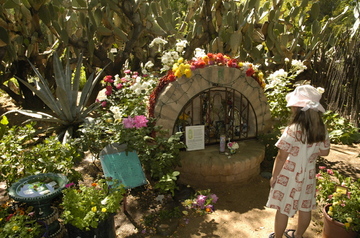
It was very useful for planning things we want to put in the back yard of the house. We’d like to obliterate the existing lawn (a water- and maintenance-hungry monster, utterly inappropriate for the desert) by xeriscaping with gravel and cactus. We were so impressed we bought a family membership, which allows us to visit as much as we want.

Of course during the visit I managed to get my knee into some cactus while snapping a picture of a lizard. I seem to get spines in my leg every couple of weeks doing one thing or another. Although the spines are straight, they still require a good tug to remove.
A month or so ago, our friends Mike & Tracy left a flyer on our doorstep for a local Mexican restaurant on Grande Ave. We went looking for it so we could get lunch, and found the street closed for a street party. Turns out it is part of Barrio Hollywood, one of the oldest neighborhoods in Tucson.

This was a huge bonus. Mexican food stands, salsa dancers on stage, a fine band, and plenty of local color. That accordian player might look anglo but let me tell you, that band could crank out some great music.
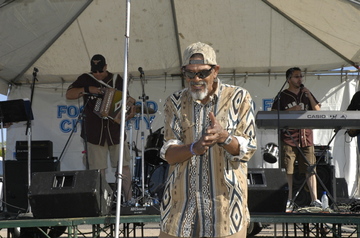
A local insisted we try a small cup of deep-fried tripe with green chiles and salsa, and then we made lunch of a burro, three tacos, strawberry Hawaiian shave ice and some churros for dessert. This festival was a lucky find. Even though we haven’t yet gone traveling yet, it feels like today we got back into the swing of it.

April 13, 2007 at 9:20 pm · Filed under Uncategorized
Oh no … have we sunk this far? We spent half of the day attending one of the local home shows, talking to vendors of replacement windows and spas and other such home improvements. I came out of there with a dizzy sensation in my head and a sinking feeling.
This is scary. We have been so free without a house all this time. We saved money and never paid real estate taxes. Now people are talking to us about spending thousands on improvements to a house we don’t even own yet, and we find ourself nodding sincerely as if this was a very logical and necessary thing to do. Sure, we need a custom closet, an outdoor kitchen, solar film on the windows, and a lifetime set of cookware. Meanwhile a voice in my head is screaming, “RUN!”
Well, we gave the home show a chance. But after four hours the only conclusion we could come to was that we didn’t need any of this stuff last week and just because we have a house coming we don’t suddenly need it now. We’ve got to keep the proper perspective — the house is a base of operations but shouldn’t become an obsession that sucks up every penny we have, and thus prevent us from being able to afford the life we really enjoy.
So I’m going to browse through all the brochures and then move on. Yes, that’s an impressive $1,100 water treatment system. Those are very lovely $2,500 rain barrels. What a pretty $3,000 murphy bed. Nice $3,879 outdoor kitchen. Wish I could have the $20,000 solar power system. Hmmm, what about a $25,000 pool?
In the end, we’ll fix up a few necessary things in the house and resist the urge to spend more improving the house than we spent on the Airstream and a year of travel. The house will get its due, but no more than that. In the big picture, it’s just another place to live that doesn’t have the advantage of wheels. This full-timing experience has really had a more significant effect on us than I had envisioned. We may never see houses the same way again.
April 12, 2007 at 9:01 pm · Filed under Uncategorized
We are having another day of blowing dust. Anytime the wind picks up there’s a likelihood that fine dust will be carried along. Having been here a couple of months, we’re starting to be able to diffentiate the types of blowing dust, much like a Vermonter knows a dozen types of snow.
Today we are getting the nearly invisible form of dust. The mountains, normally crystal clear and stunning against the azure sky, begin to fade in color, and then gradually succumb to what appears to be a whitish haze. In the east, I would interpret this as humidity, but here it is the fine dust floating evenly in the air.
When the wind really begins to blow, the dust gets into the trailer and within hours we can feel a gritty coating on all horizontal surfaces. That’s when the windows get closed. Outside, you can taste the dust if you are foolish enough (as I was) to try.
Some days we’ll spot a dark brown cloud whirling off a few miles away — those are dust storms, and they can be very large. The visibility in a dust storm can drop to zero in moments, and seeing one will give you an appreciation for what Dorothy went through on her way to the Land of Oz. You don’t want to run into one on the Interstate highway (video clip).
Our campsite is about 15 miles from the Santa Catalinas, so I use them to judge the air quality. They have yet to disappear, so I can’t really complain about the view. In the east it would be common to lose a mountain range behind clouds or even summer haze, but it doesn’t seem to happen much here. The view is almost always to the horizon. I think that’s part of what makes the west seem so endless.
Hummingbird season is upon us. We’re seeing them everywhere now. Southeast of here, near Sierra Vista, are the best places in the USA to spot hummingbirds, and once we get things wrapped up here — hopefully next week — we will hitch up and go see them. The Airstream is crying out to get rolling again, and we’ve got to keep it happy.
April 11, 2007 at 9:12 pm · Filed under Uncategorized
Today was home inspection day.
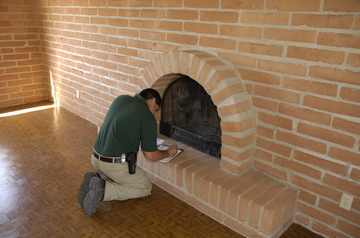
The house needs some roof work but overall it passed. So that step is done. With each milestone we get closer to being able to head out on the road again.
I’m beginning to realize that we are getting closer to our ideal. Over the past few days I’ve been exchanging email with blog reader Mike Young. As he and his wife head transition into retirement, they’ve come to many of the same conclusions as us.
Mike writes, “As a travel trailer rather than a full-time mobile home, the Airstream is ideally suited to the strategy that you and I have. A fixed home in a nice place during the coldest, wettest, shortest days/months of the year and a mobile home during the summers when outdoor living is attractive in most of the US seems like the ideal solution for those who love to maximize the opportunities to enjoy the great outdoors. House + Airstream. Perfect.”
Of course, life is rarely that simple, and as you know our life is complicated by the demands of work and family, like most other people’s lives. We aren’t retired, so this two-home strategy won’t be a piece of cake. But it seems worth investing in, even with the inevitable compromises. Our challenges and successes in executing this strategy will be a major theme of this blog going forward.
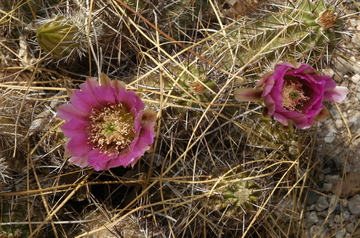
Here in our temporary home at the RV resort, the desert is blooming for springtime. The cacti respond well when they’ve been watered, and the cacti here are well pampered.
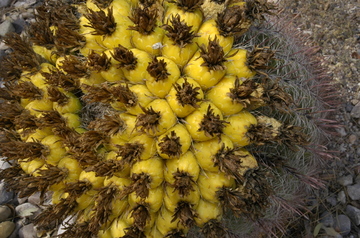
Fishhook barrel cactus with fruiting bodies
Today Emma is feeling much better, although not fully recovered, and it is absolutely beautiful outside with comfortable temperatures, so we took her for a photographic safari around the park.
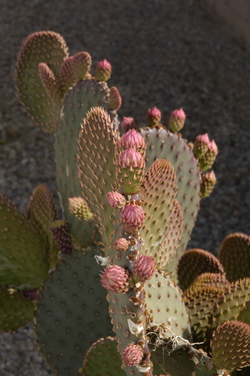
Beaver tail cactus
At first glance it seems as though nothing is blooming, until you take a closer look. Desert flowers range from showy to subtle, but most fall in the “subtle” category. You need to slow down and look closely to see the more delicate flowers.

Coral Aloe flowers
As frequent travelers, a big part of our house strategy depends on everything being “low care”. It’s easy to overlook the plantings. I don’t want to come back to dead things, and I don’t want to have to worry about pruning, watering, fertilizing, etc.
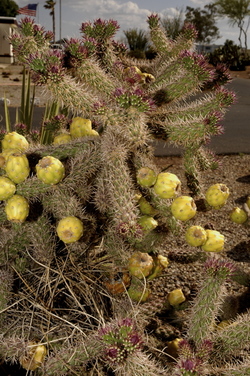
Some of the plants here in the park are native, but the most dramatic ones tend to be exotics. Part of our reason for studying them is to decide what sort of things we’d like in our backyard. I think for the most part we’ll aim for native plants. They are adapted to the climate and need very little care or water.
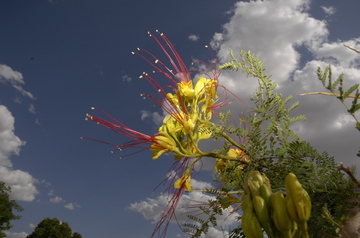
Just northeast of here is the Ironwood Forest. The town of Oro Valley and Marana sit in the middle of this “forest”, which is not like an eastern forest with trees, but rather a dense area of desert plants that has a distinctive look. Saguaro, ocotillo, elephant ear, palo verde, mesquite, agave, and many others grow there. It’s very attractive and lush-looking. I’d like to bring some of that look to our backyard.
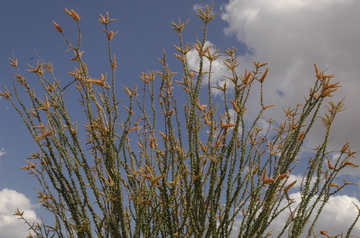
Octotillo in bloom (technically not a cactus)
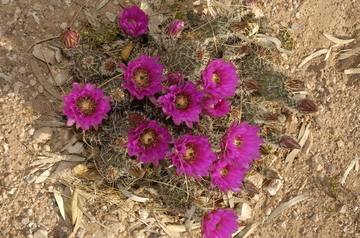
Hedgehog cactus in bloom
April 10, 2007 at 7:51 pm · Filed under Uncategorized
Emma woke up in the middle of last night with the classic barking cough of croup, and today she has been pretty much knocked flat with a virus. So except for me running out this morning to meet the gas plumbing man at our house-to-be, we’ve stayed close to the trailer all day, to let her rest.
Even with a full day working on the Fall magazine, this gave me an extra hour or two in the day. Emma was sleeping through the time we’d normally be out at the swimming pool or riding bicycles around the park. I decided to use that time to chase down the rest of the story of water in the southwest. It’s more interesting than I had expected, at least to me.
Here’s an oversimplified version of the story. California, Arizona, and Nevada don’t have enough water, and all three states have overdrawn their natural aquifers in the past century. Southern California in particular is a huge consumer of water, with a large population and huge vegetable farming in the Imperial Valley.
This isn’t news. In fact, it was so much of a problem that by 1922 a massive interstate agreement was struck between all of the states that the Colorado River passes through, to divvy up the water. Basically everyone saw that California would suck the river dry if left alone, and so the compact was a way to ensure that didn’t happen.
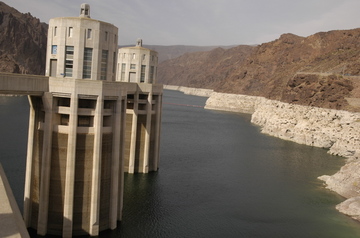
Low water at Hoover Dam
Fast-forward the 1960’s. Arizona has an allocation of water from the river but has no ability to make use of it in the population centers. So Arizona finally gets Congress to agree to a $3 billion canal to take water from Lake Havasu to a spot just south of Tucson. This canal is designed to bring Arizona’s share of the Colorado River to where it’s needed.
Fast-forward to 1993, when the canal (called the “Central Arizona Project“) is finally done. The finished canal is 80 feet wide and 336 miles long, and so expensive it will take 50 years to pay off. Here in Tucson, we pay a surcharge of 4 cents per 784 gallons of water, to help pay for it. CAP can deliver up to 2.2 million acre-feet of water each year, which is most of the 2.8 million acre-feet Arizona is entitled to under the 1922 agreement.
Still, in the early 1990s Arizona wasn’t using all the river water it was allocated. It was still consuming more underground water than Colorado River water. In the late 1990s the state started “banking” water by recharging the aquifer, like the Avra Valley project I mentioned yesterday, which has two positive effects. First, it helps slow down the draining the aquifer, and second, it gives Arizona the ability to buy and sell water credits. If another state doesn’t use all of its annual water allocation, Arizona can store it underground, and give it back later by forgoing part of its share of the river.
This all sounds peachy, but the fact remains that Arizona still uses more water from the underground aquifer than it is putting back in. The “bank” is operating at a loss. In the financial world, this would lead to bankruptcy, and the result with water won’t be much different — unless something changes.
And things will change. I am optimistic. I know that engineers, politicians, and conservationists are endlessly creative. The solutions developed so far have brought the southwestern states much farther than one would have thought possible just a few decades ago. The ticking deadline keeps getting extended through technology, invention, and compromise, driven by necessity. This is why I am not worried about the sky falling while we own a house in Tucson.
In a couple of days Emma will be well again and we will once again go for a swim in the pool. While we’re in there, I know I’ll be thinking about the water that fills it, and the challenges that must be faced if we are going to keep it full in the decades to come. In a couple of weeks, when we are at the Grand Canyon, and Lake Mead, I’ll be reminded of this story again. In the southwest desert, you are never far from the thought of water.
April 9, 2007 at 9:24 pm · Filed under Uncategorized
Since we started looking for property here, I have heard from many people about water issues in the desert. No question, it’s a desert and water is precious. Tucson and much of Arizona draw water from a giant underground aquifer which is not naturally refilling nearly as fast as it is being drawn down.
In addition to water use restrictions and financial incentives to conserve, the solution has been to negotiate a share of the overburdened Colorado River. This water is being put in giant basins in the Avra Valley and simply left to soak into the ground, thus recharging the underground aquifer. Tucson has an allocation of 44 billion gallons per year, although it doesn’t presently have the ability to make use of it all right now.
That’s a good start, but not enough forever. Still, it doesn’t appear that Tucson will run short of water anytime in the next few years, despite the many gloomy predictions I have heard.
I also hear a lot of other stories from people about how awful it is here. Come to think of it, I hear those stories everywhere that life is good. My theory is that people come up with such tales to discourage outsiders from moving in. In addition to reports of imminent drought, I’ve heard about “deadly” scorpions on the ceiling, scorching heat, black widow spiders, rattlesnakes, and killer bees. As with all such stories, there is a grain of truth to each, just enough to be slightly believable.
We’ve been looking for rattlesnakes on all our hikes in Saguaro National Park, Organ Pipe Cactus, etc. So far no luck. Most people never seen one. Bert, Janie, and I were hiking in Organ Pipe a few weeks ago in a spot that is reputed to have more rattlers than any other place in the USA (200 per square mile), but we couldn’t find any.
The scorpions are generally not deadly, except for the bark scorpion which can be deadly in some circumstances. But worrying about it is pointless: hardly anyone has ever been killed by one. Same for the black widow spider.
The water issue is of more interest to us. Our travels by Airstream have changed how we view water. With only a 39-gallon supply that often has to last for several days when we are boondocking, it’s important to know how to conserve. Tucson Water says the average usage per person is 177 gallons per day. (That includes water used for all purposes, including irrigation.) In the Airstream, our average use per person can be as low as 3.5 gallons per day when boondocking, and probably runs about 8 gallons per day when we have full hookups.
I’ve noticed that when we’re borrowing a shower in someone’s house, I am now compelled to shut off the water between soapings, just as I routinely do in the Airstream. I notice little water-wasting moments: the neighbor sloshing his car with gallons of water in the driveway, or a pool that is left uncovered to evaporate all day in a dry climate. The other day Eleanor spotted someone cleaning the sidewalk with a hose and was outraged. Even a regular flush toilet seems like an extravagance now.
So in our house we want to incorporate some RV economization principles for water (and power, but I’ll get to that another day). When we move in, I expect we’ll make several changes to cut our water usage, including water-saving appliances, a drip irrigation system, and even a rainwater harvesting system with rain barrels for watering the plants. It should be interesting and fun to try to apply what we’ve learned to our stationary house.
« Previous entries ·
Next entries »
















